Potřebujeme váš souhlas k využití jednotlivých dat, aby se vám mimo jiné mohly ukazovat informace týkající se vašich zájmů. Souhlas udělíte kliknutím na tlačítko „OK“.
ASTM C1323-10
Standard Test Method for Ultimate Strength of Advanced Ceramics with Diametrally Compressed C-Ring Specimens at Ambient Temperature
Automaticky přeložený název:
Standardní zkušební metoda pro konečné pevnosti pokročilých keramiky s diametrálně komprimované C-Ring vzorků při pokojové teplotě
NORMA vydána dne 1.1.2010
Informace o normě:
Označení normy: ASTM C1323-10
Poznámka: NEPLATNÁ
Datum vydání normy: 1.1.2010
Kód zboží: NS-10684
Počet stran: 8
Přibližná hmotnost: 24 g (0.05 liber)
Země: Americká technická norma
Kategorie: Technické normy ASTM
Kategorie - podobné normy:
Anotace textu normy ASTM C1323-10 :
Keywords:
advanced ceramic, C-ring specimen, uniaxial strength, Advanced ceramics, C-ring specimens, Monotonic compressive strength, Strength--ceramic materials/applications, Ultimate strength, ICS Number Code 81.060.30 (Advanced ceramics)
Doplňující informace
| Significance and Use | ||||||||||||||||||||
|
This test method may be used for material development, material comparison, quality assurance, and characterization. Extreme care should be exercised when generating design data. For a C-ring under diametral compression, the maximum tensile stress occurs at the outer surface. Hence, the C-ring specimen loaded in compression will predominately evaluate the strength distribution and flaw population(s) on the external surface of a tubular component. Accordingly, the condition of the inner surface may be of lesser consequence in specimen preparation and testing. Note 1—A C-ring in tension or an O-ring in compression may be used to evaluate the internal surface. The flexure stress is computed based on simple curved-beam theory (1, 2, 3, 4, 5). It is assumed that the material is isotropic and homogeneous, the moduli of elasticity are identical in compression or tension, and the material is linearly elastic. These homogeneity and isotropy assumptions preclude the use of this standard for continuous fiber reinforced composites. Average grain size(s) should be no greater than one fiftieth (1/50) of the C-ring thickness. The simple curved-beam theory stress solution is in good agreement (typically better than 1%) with a theory of elasticity solution as discussed in (3) for the geometries chosen for this standard. The simple beam theory stress equations are relatively simple. They are relatively easy to integrate for Weibull effective volume or effective area computations as shown in Appendix X1. The simple curved beam and theory of elasticity stress solutions both are two-dimensional plane stress solutions. They do not account for stresses in the axial (parallel to b) direction, or variations in the circumferential (hoop, σθ) stresses through the width (b) of the test piece. The variations in the circumferential stresses increase with increases in width (b) and ring thickness (t). The variations can be substantial (> 10 %) for test specimens with large b. The circumferential stresses peak at the outer edges. Therefore, the width (b) and thickness (t) of the specimens permitted in this test method are limited so that axial stresses are negligible (see Ref. 5) and the variations of the circumferential stresses from the nominal simple curved beam theory stress calculations are typically less than 4 %. See Ref. (3) and (4) for more information on the variation of the circumferential stresses as a function of ring thickness (t) and ring width (b). The test piece outer rim corners are vulnerable to edge damage, another reason to minimize the differences in the circumferential stresses across the ring outer surface. Other geometry C–ring test specimens may be tested, but comprehensive finite element analyses shall be performed to obtain accurate stress distributions. If strengths are to be scaled (converted) to strengths of other sizes or geometries, then Weibull effective volumes or areas shall be computed using the results of the finite element analyses. Because advanced ceramics exhibiting brittle behavior generally fracture catastrophically from a single dominant flaw for a particular tensile stress field, the surface area and volume of material subjected to tensile stresses is a significant factor in determining the ultimate strength. Moreover, because of the statistical distribution of the flaw population(s) in advanced ceramics exhibiting brittle behavior, a sufficient number of specimens at each testing condition is required for statistical analysis and design. This test method provides guidelines for the number of specimens that should be tested for these purposes (see 8.4). Because of a multitude of factors related to materials processing and component fabrication, the results of C-ring tests from a particular material or selected portions of a part, or both, may not necessarily represent the strength and deformation properties of the full-size end product or its in-service behavior. The ultimate strength of a ceramic material may be influenced by slow crack growth or stress corrosion, or both, and is therefore, sensitive to the testing mode, testing rate, or environmental influences, or a combination thereof. Testing at sufficiently rapid rates as outlined in this test method may minimize the consequences of subcritical (slow) crack growth or stress corrosion. The flexural behavior and strength of an advanced monolithic ceramic are dependent on the material's inherent resistance to fracture, the presence of flaws, or damage accumulation processes, or a combination thereof. Analysis of fracture surfaces and fractography, though beyond the scope of this test method, is highly recommended (further guidance may be obtained from Practice C1322 and Ref (6)). |
||||||||||||||||||||
| 1. Scope | ||||||||||||||||||||
|
1.1 This test method covers the determination of ultimate strength under monotonic loading of advanced ceramics in tubular form at ambient temperatures. The ultimate strength as used in this test method refers to the strength obtained under monotonic compressive loading of C-ring specimens such as shown in Fig. 1 where monotonic refers to a continuous nonstop test rate with no reversals from test initiation to final fracture. This method permits a range of sizes and shapes since test specimens may be prepared from a variety of tubular structures. The method may be used with microminiature test specimens. 1.2 The values stated in SI units are to be regarded as standard. No other units of measurement are included in this standard. 1.2.1 Values expressed in this test method are in accordance with the International System of Units (SI) and . 1.3 This standard does not purport to address all of the safety concerns, if any, associated with its use. It is the responsibility of the user of this standard to establish appropriate safety and health practices and determine the applicability of regulatory limitations prior to use. |
||||||||||||||||||||
| 2. Referenced Documents | ||||||||||||||||||||
|
Podobné normy:
Historická
1.6.2010
Historická
1.12.2010
Historická
15.7.2010
Historická
1.8.2013
Historická
1.8.2008
Historická
1.8.2012
Doporučujeme:
Aktualizace zákonů
Chcete mít jistotu o platnosti užívaných předpisů?
Nabízíme Vám řešení, abyste mohli používat stále platné (aktuální) legislativní předpisy.
Chcete vědět více informací? Podívejte se na tuto stránku.


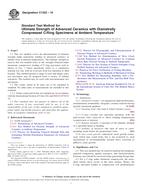
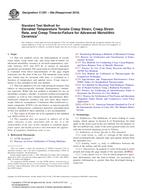 ASTM C1291-00a(2010)..
ASTM C1291-00a(2010).. ASTM C1292-10
ASTM C1292-10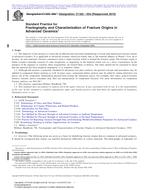 ASTM C1322-05b(2010)..
ASTM C1322-05b(2010)..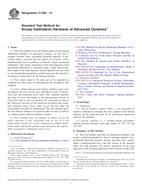 ASTM C1326-13
ASTM C1326-13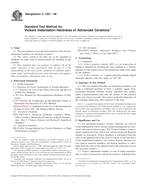 ASTM C1327-08
ASTM C1327-08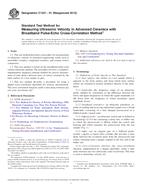 ASTM C1331-01(2012)..
ASTM C1331-01(2012)..
 Cookies
Cookies
